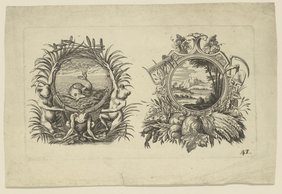The print shows two elaborately decorated cartouches. On the left, three frogs present a round frame bound from cattails, which offers a view of a wide sea with an imposing dolphin in the centre. On the right, a tondo shows the winding course of a river with a small village and high mountains in the background. Harvesting tools and lush crops frame the landscape depiction. In the lower right corner, within the clearly visible plate margin, the plate number "31" can be seen, which was corrected in pen to "42". No further information about the designer or etcher is noted. It has not yet been possible to determine the series from which the print originates. The motifs, however, were taken from and recombined with the famous "Tapisseries du Roy Ou Sont Representez Les Quatre Elemens Et Les Quatre Saisons ", which were published at the end of the 17th century and appeared in several editions and translations (Seeger 2010).
The "Tapisseries du Roy" present two tapestry series - The Four Elements and The Four Seasons - from the royal Gobelin Manufactory of Louis IVX. The project comprised eight cartoons by Charles Le Brun (1619–1690) with allegorical-mythological depictions. Each of these depictions was accompanied by four corner medallions with mottos. Verses by Charles Perrault (1628–1703) and others, as well as explanatory notes by André Félibien (1619–1695), describe the meaning of the images and their connection to the Sun King's glorious and distinguished reign. The texts were published first, followed by a sumptuously illuminated manuscript for the king, in which the artist Jacques Bailly (1629–1679) staged each motto individually and provided it with a magnificent cartouche (Paris, BnF, Français 7819). Finally, in 1679, a state-authorised printed edition with engravings by Sébastien LeClerc (1637–1714) was published by Marbre-Cramoisy in Paris, which faithfully reproduced Bailly's drawings and also included both the verses and the explanatory notes.
In the two capricci, the elaborate cartouches are simplified and modified: The frogs that frame a river landscape in the "Tapisseries" in devise XI "Pour la Bonté dans la pièce de l'element de l'eau" present here the image of the dolphin from devise XII "Pour la Valeur dans la pièce de l'element de l'eau", which Bailly had framed with a cartouche of shells, nautilus cups and sea creatures. The right medallion with river landscape is a variation of the above-mentioned devise XI and is fitted into the highly simplified cartouche with harvesting tools and fruits of devise XVI "Pour la Magnanimité dans la pièce de l'elelemt de la terre".
In the Haupt Collection, besides the two capricci, there are 28 cut-out prints with mottos among the graphic single sheets, which, however, do not come from the French edition, but from the reprints (1687 and 1690) by Johann Ulrich Kraus (1655–1719). The Augsburg engraver and publisher issued several editions of the "Tapisseries" in French with a German translation from 1687 onwards. His wife Johanna Sibylla Ulrich (1650–1717, née Küsel) meticulously copied the illustrations that appeared in the reversed sense. Albrecht Haupt furthermore owned a bound edition of the "Tapisseries" from Kraus' publishing house, in which the emblematic page layout was abandoned, in order to arrange two copperplates per page on top of each other in the pictorial section separated from the text (TIB, 4 Haupt 627). Equipped with the extensive comparative material of his own collection, it was possible for Haupt, and it is also possible for us today, to classify the capricci shown here. Completely deprived of their panegyric intention, they are a testimony to French court art, but also bear witness to the sometimes stencil-like use of motifs disseminated through prints.
br

